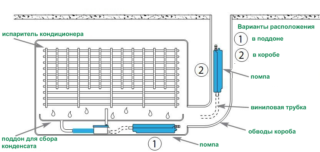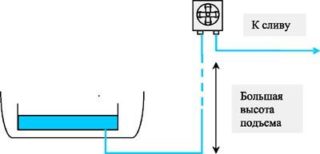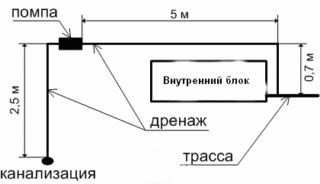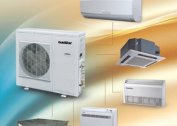During operation of any air conditioner, a large amount of condensate is formed. In order to bring the accumulated liquid out, the air conditioners are equipped with a drainage system, which includes a special drain pan designed to collect condensate, a drainage pipe through which accumulated moisture is discharged outside the premises and a drainage pump through which condensate is pumped.
Duct and cassette air conditioners, as well as split systems and premium air conditioning, are equipped with a built-in drainage pump. Budget models, as a rule, do not have it, so you have to purchase a drain pump for the air conditioner separately.
Sometimes when laying a drainage pipeline, even a built-in pump cannot ensure that condensate rises to a height sufficient to drain it by gravity. In this case, an additional vacuum pump for air conditioners is selected and installed.
Types of drainage pumps and the principle of their work
 When arranging drainage in air conditioning systems, pumping units of the following types are used:
When arranging drainage in air conditioning systems, pumping units of the following types are used:
- recessed;
- separate;
- bulk;
- peristaltic.
All of them work almost silently. A slight noise from the operation of the pumps is drowned out by the sounds that emit elements of the working units of the air conditioners.
Despite the various layout solutions, drainage pumping units are assembled from similar units:
- storage tank where condensate is collected;
- liquid level sensor (float);
- the pump itself;
- a pipe designed to drain water.
There are pumps in which, instead of the float, heat-sensitive sensors are installed that react to contact with water or the drying of the sump.
In turn, the pump itself constructively includes:
- power electric drive;
- the working area in which the fluid flows;
- 2 cast nozzles - suction and pressure;
All drainage pumps, regardless of their type, work the same way: during the accumulation of condensate, the float rises, reaching a certain level, closes the contacts that drive the pump. The pump pumps out the accumulated liquid until the float falls into place and the electrical control circuit opens.
Drainage pumps are equipped with three-level liquid level sensors, which operate as follows:
- I level - the pump is turned off, since there is no water in the storage tank;
- II level - it is necessary to remove water from the storage tank - the sensor gives a signal to turn on the pump;
- III level - emergency - the sensor signals that the amount of accumulated condensate has exceeded the permissible level and the air conditioner must be turned off. In this case, emergency shutdown is implemented individually in each model.
Built-in pumps
 The drain pump built into the air conditioner housing is designed in such a way that it can be fixed not only inside the storage tank, but also on the outlet pipe or drain hose. Structurally, the unit is a monoblock, in which in addition to the pump there is also a control module and a condensate level sensor. Functionally, the pump must ensure that the water rises in the discharge pipe, and therefore the pump itself should be located below the liquid level.
The drain pump built into the air conditioner housing is designed in such a way that it can be fixed not only inside the storage tank, but also on the outlet pipe or drain hose. Structurally, the unit is a monoblock, in which in addition to the pump there is also a control module and a condensate level sensor. Functionally, the pump must ensure that the water rises in the discharge pipe, and therefore the pump itself should be located below the liquid level.
The performance of the integrated drainage pump is in the range of 5 to 150 l / h. The built-in pumps differ from other pumping units in small sizes, which is due to the conditions of their placement.Devices of this type are usually equipped with ducted and central air conditioners of low power.
Separate pumps
Unlike built-in pumps, separate pumps are structurally a two-unit design. In one block there is a pump and a control module, in the other there is a storage tank and a liquid level sensor. The blocks are connected by a flexible water hose and electric wires coming from the float.
The block, which contains the storage tank, is small in size, which allows you to place it directly in the drain pan or outside. The pump unit is installed outside the air conditioner case, for example, in the box of the Freon line, and can be located above the liquid level in the drain pan. At the same time, the distance to it from the indoor unit of the air conditioner should not be more than 2 meters.
According to their technical characteristics, split type pumps are capable of lifting water up to a height of 14 m, while ensuring performance in the range from 8 to 60 l / h.
Separate drainage pumps for air conditioners are installed when organizing air conditioning systems of small capacity, equipped with internal wall or floor-ceiling units.
Filling pumps
When organizing a large-capacity air conditioning system, monoblock bulk drainage pumps are used. They differ from other units in the presence of a large storage tank into which condensate flows by gravity. In turn, this design requires that the pump be installed below the drain pan of the air conditioner.
Liquid pumps are able to raise water to a height of up to 3 meters, while ensuring high productivity (from 80 to 1500 l / h). They are most often installed in horizontal drainage pipelines that allow condensate to drain into the sewer.
Peristaltic pumps
 In those cases when when laying drainage pipelines there are large differences in height (over 15 m), peristaltic drainage pumps are used. They differ from other pumping units in that they begin to work either on command from the air conditioning compressor, or on a signal from a temperature sensor installed on its evaporator. In addition, the peristaltic pump allows the connection to a storage tank of a separate pump equipped with a liquid level sensor.
In those cases when when laying drainage pipelines there are large differences in height (over 15 m), peristaltic drainage pumps are used. They differ from other pumping units in that they begin to work either on command from the air conditioning compressor, or on a signal from a temperature sensor installed on its evaporator. In addition, the peristaltic pump allows the connection to a storage tank of a separate pump equipped with a liquid level sensor.
Due to the fact that these units have a small capacity (up to 10 l / h), they are used when organizing industrial or office air conditioning systems of low power, characterized by a significant length of the vertical sections of drainage pipelines. The need for their use in air conditioning of residential premises, as a rule, is absent.
Criterias of choice
Drainage pumps belong to the category of products with long service life. They can only fail if they are not properly maintained. In practice, the issue of acquiring an additional pump most often arises when designing a drainage pipeline route.
When choosing a pump, it is necessary to take into account the power of the air conditioner and the features of its design. It is important not to miss the nuances of the interior of the room where it is planned to install the air conditioning device, as well as determine the location of the condensate drain point and its distance from the drainage pump.
The pump parameters have a big impact on the efficiency of the drainage system:
- power;
- performance;
- noise level;
- weight;
- dimensions.
When choosing a drainage pump, experts recommend purchasing products made by well-known companies. Otherwise, a potential consumer may be faced with the fact that a newly acquired pump for a split system will stop working.In this case, most often in it fail:
- control module;
- fluid level sensor;
- electric motor.
Installation Features
 Before proceeding with the installation of a drainage pump for air conditioners, you must make sure that its performance stated in the accompanying documentation meets the specific parameters of the developed condensate drainage system. For this purpose, the actual pump capacity is calculated using a special technique based on the fact that the volume of condensate emitted is at least 0.8 l / h per 1 kW of cooling capacity. The calculation also takes into account the configuration of the drainage pipeline. If, according to the calculation results, the capacity exceeds its standard value, the pump is selected correctly.
Before proceeding with the installation of a drainage pump for air conditioners, you must make sure that its performance stated in the accompanying documentation meets the specific parameters of the developed condensate drainage system. For this purpose, the actual pump capacity is calculated using a special technique based on the fact that the volume of condensate emitted is at least 0.8 l / h per 1 kW of cooling capacity. The calculation also takes into account the configuration of the drainage pipeline. If, according to the calculation results, the capacity exceeds its standard value, the pump is selected correctly.
The accompanying documentation included with the delivery of any drainage pump contains all the necessary recommendations for its installation. There are a number of general requirements that must be considered when starting work on equipping the air conditioner with an additional pump:
- It is recommended to install and securely hold the storage tanks in a horizontal position;
- reliable heat removal from the fuel parts of the pump should be ensured;
- all electrical connections must be made in accordance with the standard electrical circuit and securely insulated;
- horizontal sections of drainage pipelines should have a slope of at least 3 °;
- the pipeline must be assembled from tubes having a design diameter.
A carefully assembled drainage system equipped with an additional correctly selected pump will solve the problem of condensate drainage from the air conditioner even in the most difficult case. This will avoid troubles in one way or another connected with water leaks: damage to the interior of the room, damage to the facade of the building, etc.


